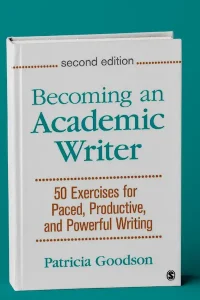Becoming an Academic Writer helps you gain control over writing and publishing, master specific aspects of academic writing, and improve your productivity.
How to Use This Book
I designed this text as a workbook for use on a daily (or regular) basis. You can adopt it as a self-paced workout, or, if you teach writing courses or work with writing groups, you may assign specific chapters to be read and practiced over a certain time period.
I guess by now you know whom I had in mind as the intended audience for this book: anyone in an academic setting who must write to survive—specifically, graduate students, postdocs, or junior faculty.
This doesn’t mean the book can’t be useful for undergraduate students, or even for writers outside academia. The audience I initially had in mind as I wrote these exercises, however, consisted of my own graduate students and faculty colleagues (keep in mind, these folks are either in education, social sciences, or public health). That I was writing for my students and colleagues explains, to some extent, the informal, conversational tone I employ throughout the book.
The book begins with a brief theoretical and empirical grounding of the exercises I propose (Chapter 1). It follows with 50 exercises (Chapters 2– 11) designed to help you establish and maintain a writing habit, as well as progress through the stages of writing a journal article or research proposal.
Appendix A offers a strategy for reading and writing simultaneously (so reviewing the literature ceases to be an excuse for not getting to the writing). Appendix B provides a list of additional useful resources.
If you are using this as a self-paced workbook, you can sail through all 50 exercises during a year, focusing on one exercise per week with a 2-week vacation (yes, rest is an important element in structured practice, even for elite performers).
You can choose to practice them more quickly, if you’d like, but keep in mind the need for practicing, which implies repeating the exercises. If you teach a semester-long class, you may need to assign several exercises per week (perhaps one chapter every week), in order to cover their contents in the standard 15-week semester. I would also recommend assigning Appendix A, on reading and writing, early, so students can begin structuring their matrices and avoid the reviewing-theliterature excuse.
One way to use the book is to start with Chapter 1 and work through Chapter 11. Depending on what your or your students’ needs are at the moment, however, you may choose to begin with any chapter and skip around.
Whichever approach you pick, remember, it’s best to do the exercises within a given chapter in sequence. Several exercises build on those practiced earlier and depend on previously developed skills.
I also think it’s a good idea to read Chapters 1 and 2 before you tackle any other chapter, because these chapters prepare the soil in which you will plant the writing-productivity seed: a healthy writing habit. Absent this habit, the idea of practicing writing regularly becomes sort of like weeds in your garden—a sheer nuisance. Not a bad idea to read Appendix A early on, as well—especially if you are the kind of writer who wants to read everything before writing.
After you have chosen a chapter, commit to starting with the first exercise and working your way in sequence to the last exercise in that chapter. You should practice one exercise per week and repeat it several times— preferably at the start of every writing session.
Remember, the more you practice, the better you will become. But the idea is not to overwhelm yourself with practice or to become tired or bored with it. That’s why the exercises are designed to be brief, so you can repeat them several times and not wear yourself out. Most exercises require merely 5 to 10 minutes of practice.


